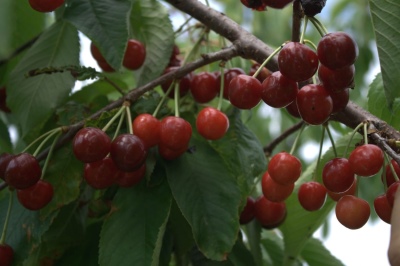
- Fruit shape: rounded
- Peduncle: short, medium thickness
- Authors: Zueva Lidia Ivanovna, Kanshina Maina Vladimirovna, Astakhov Alexey Alexandrovich
- Year of approval: 2011
- Growth type: medium-sized
- Appointment: universal
- Yield: high
- Tree height, m: 3-4
- Crown: sprawling, round-oval, medium density
- Escapes: thick, vertical at the top of the crown, horizontal at the bottom, brown-gray, glabrous
A variety of sweet cherries Lyubimitsa Astakhova is considered a northern variety. In the process of breeding it, experts tried to get a culture that would easily tolerate the harsh and cold climate. According to many gardeners, breeders managed to get a crop with strong immunity, high frost resistance, tasty berries and other characteristics.
Description of the variety
The growth of medium-sized trees is from 3 to 4 meters. The variety forms a medium in density and spreading crown of a rounded-oval shape. Shoots grow massive. At the bottom of the crown, they are horizontal, covered with brown-gray bark, and at the top, they are vertical.
Leaves are bright green, with a matte surface, elliptical in shape, medium in size. Flowers are medium-sized, saucer-shaped. The petals are white. Three flowers are collected in one inflorescence. They grow mainly on bouquet shoots.
Fruit characteristics
The sizes of the berries are large, and each weighs about eight grams in weight. The shape is standard, round. The skin is colored in a rich burgundy shade (dark red). The crop is formed on small stalks of medium thickness. Juicy pulp grows under the smooth and delicate skin. The color of the berries is the same inside and outside. If you make juice or compote from ripe berries, it will acquire the same rich and bright color.
Harvesting is very easy thanks to the good separation. The brown, rounded bone is easily detached from the pulp. When eating fresh berries, the skin is not felt. If the berries are not picked in time, their color will become darker, almost black. This color indicates that the fruit is overripe. Ripe cherries are suitable for drying or freezing.
Taste qualities
The taste is balanced and sweet, the same as that of the southern varieties of cherries. Assessment of professional tasters - 4.8 points, which indicates excellent gastronomic qualities. Acids in fruits - 0.64%, and sugars - 12.4%. The dry matter is 17%. Due to the universal purpose of the fruits, many aromatic, sweet and juicy delicacies can be prepared from them.
Ripening and fruiting
The first cherries appear on the branches only in the fifth year after planting. Ripening dates - late or mid-late, it all depends on the weather conditions in each region. The first crop is harvested in early July or in the middle of this month.

Yield
Due to its high yield, the variety quickly attracted the attention of gardeners from different regions of the country.The average figure is about 71.2 centners per hectare of garden. Marketability, as well as transportability, will be on top. Even fully ripe berries can easily transfer transportation over long distances, while maintaining an attractive appearance.
To keep the crop longer, it is advisable to harvest it early in the morning. It is at this time of the day that the cherry has the most dense consistency. It is advisable to store the berries in the refrigerator, since at room temperature they retain their taste and integrity for no more than 3 days.
Summer residents familiar with this variety point to its stable yield, which persists from year to year. Each season, about 10 kilograms of bright and healthy berries are obtained from one tree.
Self-fertility and the need for pollinators
Sweet cherry Lyubimitsa Astakhova can bear fruit without pollinators, but due to the fact that the culture is only partially self-fertile, you should not count on a rich harvest. If pollinating crops grow nearby, fruiting will increase markedly (by 2-3 times). When growing a tree in a small garden area, you can solve the problem with the help of grafting.
Growing and care
This variety can be safely chosen by gardeners without experience, since this type of sweet cherry is unpretentious. She does not need special care, but she will have to comply with certain norms. For the berries to be juicy and tasty, they need enough moisture, otherwise they will be dry. Excessive watering will also adversely affect the taste of the crop.
Trees are watered once a week, the frequency of watering may vary depending on weather conditions. In the hot season, watering is performed 2-3 times more often. For one plant, use 1-2 buckets of settled water, which is poured into the root zone.
Cherries are fertilized only from the second year after planting. Each period has its own mineral compositions and substances. Nitrogen fertilizers are applied in the spring, helping the tree to build up a healthy green mass, in the spring they switch to nitrogen mixtures, potash compositions are used during the period of opening the buds. In autumn, trees need phosphorus fertilization. To improve the yield, every three years, you should dig the soil around the trunk circle and add 10-20 kilograms of humus.
The Lyubimitsa Astakhova variety reacts poorly to pruning, so this procedure should be performed only as needed. As a rule, formative or sanitary pruning is carried out. In the first case, the crown is made more accurate, in the second, they get rid of broken, diseased and unnecessary branches.





































































